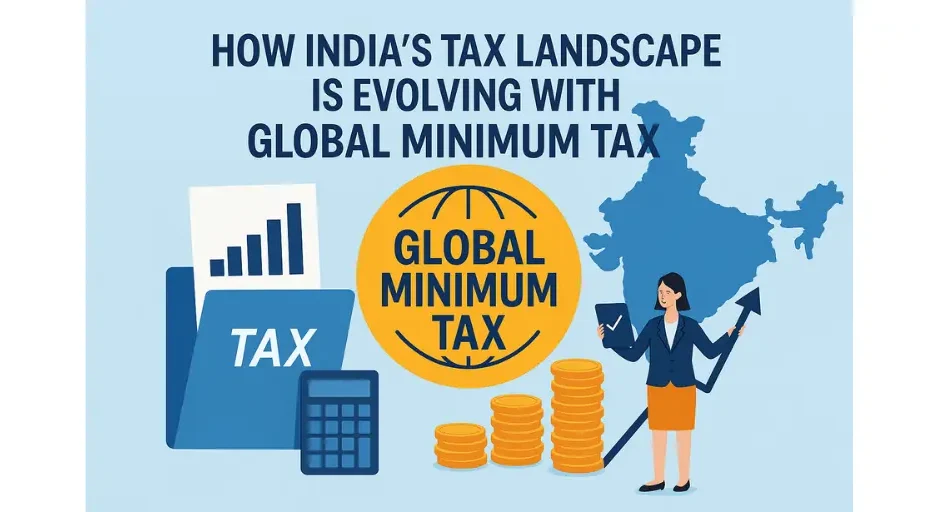How India’s Tax Landscape Is Evolving with Global Minimum Tax
In recent years, tax regimes worldwide have faced increasing scrutiny, with growing pressure to curb tax base erosion and profit shifting by multinational corporations (MNCs). At the heart of this global reform is the introduction of the global minimum tax—a landmark agreement spearheaded by the Organisation for Economic Co-operation and Development (OECD) and supported by over 140 countries, including India. This transformative tax framework is reshaping how nations think about taxation, sovereignty, and corporate compliance.
India, with its growing digital economy and increasing foreign investments, stands at a critical juncture. The adoption and implementation of the global minimum tax represent both a challenge and an opportunity for the country. As the international tax landscape undergoes a seismic shift, India’s tax policies are evolving to align with the global consensus while protecting its own fiscal interests.
Understanding the Global Minimum Tax
The global minimum tax is a concept born out of the OECD’s Base Erosion and Profit Shifting (BEPS) 2.0 framework. It aims to ensure that large multinational enterprises (MNEs) with revenues above €750 million pay at least a 15% tax rate on their global income, regardless of where they are headquartered or operate. The initiative comprises two main pillars:
Pillar One: Re-allocates taxing rights to market jurisdictions, especially targeting digital giants, allowing countries like India to tax a portion of global profits earned locally.
Pillar Two: Introduces the global minimum tax, designed to stop the “race to the bottom” where countries compete for investments by offering ultra-low tax rates.
India has historically supported global efforts to curb tax avoidance, and the global minimum tax fits well into its long-term strategy to ensure equitable taxation.
India’s Position and Adaptation Strategy
India was among the first major economies to endorse the global minimum tax proposal. While India already imposes relatively high corporate tax rates—ranging from 22% for domestic companies (15% for new manufacturing units)—the new rules are not about increasing tax rates domestically. Instead, they are about ensuring that income earned by Indian subsidiaries of foreign MNCs is not taxed less than the 15% threshold in other jurisdictions.
This has led the Indian government to:
Re-evaluate existing tax treaties and incentives: India offers several tax holidays and concessions, especially in sectors like IT, manufacturing, and SEZs. These incentives are under review to ensure compatibility with the global minimum tax norms.
Align domestic laws with global standards: The government is assessing the need for legislative amendments to incorporate the OECD’s model rules under Pillar Two.
Enhance digital tax frameworks: With its existing Equalisation Levy and earlier push for a Digital Services Tax (DST), India is poised to transition from unilateral measures to multilateral solutions under Pillar One.
Impact on Indian Multinationals and Foreign Companies
The global minimum tax will have profound implications for Indian-headquartered multinationals like Infosys, Wipro, Tata Group, and Reliance, which operate in multiple jurisdictions. If any of their foreign subsidiaries pay tax below 15%, India could apply a “top-up” tax under the Income Inclusion Rule (IIR) to bridge the gap.
For foreign MNCs operating in India, the new rules ensure a level playing field and eliminate the incentive to shift profits to low-tax jurisdictions. While this may increase the overall tax burden for some companies, it also reduces the risks associated with aggressive tax planning.
Key implications include:
Increased compliance requirements: Companies must reassess their global tax structures and ensure data transparency across jurisdictions.
Shift in investment strategies: Tax considerations may no longer drive decisions on subsidiary locations or IP holdings.
Greater clarity and stability: Uniform global tax norms reduce the risk of disputes and double taxation.
Challenges Ahead for India
While the global minimum tax presents many benefits, implementation won’t be without hurdles. Key challenges include:
Administrative complexity: Calculating effective tax rates across multiple jurisdictions, applying carve-outs, and adjusting for temporary differences will require significant infrastructure and training.
Treaty renegotiations: India will need to rework several bilateral tax treaties to accommodate new profit allocation and minimum tax mechanisms.
Impact on tax incentives: SEZs, start-ups, and other sectors that currently benefit from lower effective tax rates might face reduced attractiveness unless the government restructures the incentives in non-tax forms.
Balancing national interest and global cooperation: While India supports the global initiative, it also seeks to ensure that developing countries do not lose out on vital tax revenues in favor of richer nations.
Opportunities for India
Despite the complexities, the global minimum tax offers several strategic advantages to India:
Revenue stability: By curbing profit shifting to tax havens, India can safeguard its corporate tax base.
Boost to domestic industry: A uniform global tax floor might encourage companies to invest in countries with large markets like India rather than choosing low-tax jurisdictions.
Improved global credibility: Active participation in the OECD-G20 framework positions India as a responsible global economic power.
Digital economy taxation: India has long advocated for fair taxation of digital businesses. The new framework helps it claim its fair share of taxes from tech giants.
Way Forward
The Finance Ministry, in consultation with experts and international agencies, is working to fine-tune India’s response to the global minimum tax. Public consultations, white papers, and impact assessments are expected in the near future.
India may also consider implementing a Qualified Domestic Minimum Top-Up Tax (QDMTT) to tax profits of MNCs within its borders to the 15% level, ensuring the revenue stays within the country instead of flowing to foreign jurisdictions through the IIR.
In addition, capacity building for tax authorities, adoption of sophisticated IT tools, and enhanced global cooperation mechanisms will be key to a successful rollout.
Conclusion
The global minimum tax marks a bold step toward a more equitable and transparent global taxation system. For India, it offers an opportunity to modernize its tax infrastructure, attract more genuine investments, and plug revenue leakages without raising tax rates.
As India adapts to this new global norm, the challenge will lie in balancing international commitments with domestic priorities. With thoughtful implementation, the global minimum tax can pave the way for a fairer tax regime that supports both economic growth and fiscal stability.
Tags:
Our GST Services

All E-commerce Tax services
E-commerce tax services help online sellers navigate GST registration, compliance, return filing, TCS management, tax planning, and audits, ensuring efficient tax management and legal compliance.

GST Filing
GST filing is the process of submitting tax returns to the government, detailing sales, purchases, and taxes paid or collected, ensuring compliance with GST laws.

GST Registration
GST registration is the process where businesses obtain a GSTIN from the government, allowing them to collect taxes, claim input tax credits, and comply with GST laws.





